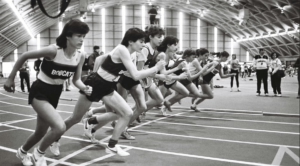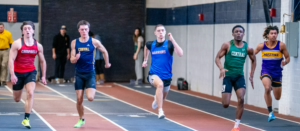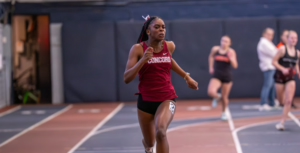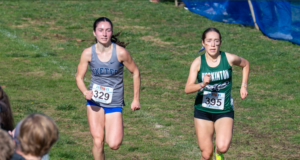At the beginning of the summer I wrote an article that hopefully all your athletes read, or were already of the mindset of getting in their summer mileage is the best way to make sure they were ready to run PRs this fall. The focus was building their mileage such that on the first day of practice they will be more aerobically fit than they’ve been at the beginning of the season, ready for the awaiting workouts. And while I guaranteed this is the best way to PR during the upcoming cross country season, coupled with staying healthy, I realized while reading it on the website what they do over the summer works in concert with what you have them doing during the season. Getting in that mileage is still the first step, but inappropriate training in season certainly can “undo” all of their best efforts.

And please don’t think this article is in judgement of any of you as coaches. I’ve written a lot about there being many ways to skin a cat, no one way being better than another. But I do have a lot of experience in developing workout systems to ensure my athletes finish the season uninjured, as that’s extremely important when you coach at a small school and have big expectations. One of the keys to success over the years for Mascenic has been to get all my athletes to the start line of the divisional championships, as healthy performers always run faster than injured ones. So with that as the framework, I’ve developed programming that helps mitigate against injury while promoting strength throughout the season.
First things first is to recognize how undertrained your athletes are. Not to say they didn’t train over the summer but realize they might feel they are better trained than they are or might be exaggerating their fitness in order not to upset the coach. Maybe you require your athletes to track everything on Strava as a way of managing them over the summer. I, for one, never wanted to do that sort of management, electing the route that IF an athlete wanted to be good, THEY would do what needed to be done. If not, there wasn’t much my goading or cajoling was going to change. And once I realized I couldn’t count on everyone doing the right thing in their summer training, I flipped the script and built into my training program “base training” for the first two weeks of the season.

At first I resisted planning this “base training” phase, not wanting to lose two weeks that I could have the athletes training and getting ahead. But over the course of a few years of adjustment I’ve come to the conclusion it’s the best and most surefire way to get the most out of all my athletes. And while we call it base, in reality it meets the athletes where they are and those kids who are ready to roll will get some training advancement. But the focus is to bring everyone along so when the real training begins, we don’t have silly, overuse issues pop up at the beginning of the season. While I could go into what this looks like, ad nauseum, I think it would be best to have those discussions directly, not via this article. If you are interested in this insight, send me a jingle.
What is really important is meeting the athlete where they are, not just with the physical part of it, but the personal, psychological part of it. Why are they running cross country? What do they hope to get out of it? How deep are they willing to dig? How important is it to compete on the big stage?

The one luxury of having small squads is having the ability to interact with everyone on the team and gain insight to these questions. A few years back (meaning 10) the squad blew up to 30 athletes, of various ability and intent. I struggled to have meaningful interactions with them on a regular basis and reached out to the principal and athletic director to bring on an assistant to help manage all of the various players. They wanted to call the position “JV” and I asked them not to do so, as I wasn’t interested in the demarcation of athletes. If you run cross country at Mascenic, show up every day and work hard, you are a Varsity athlete regardless of your times. I did not want my athletes to think I was the Varsity coach and I only worked with Varsity athletes. I just needed an extra set of eyes to make sure we didn’t let anything slip through the cracks. The sell to the administration was they would never allow a teacher to manage 30 students on a field trip alone, how is it OK to expect a single coach to do so?
Understanding an athlete’s motivation in a sport is key to figuring out what makes them tick. I’ve had countless athletes arrive to the sport stating they don’t like competing then become some of the fiercest competitors on the starting line. Once they realize it’s them against themselves, and the other competitors are tools to get the most out of themselves, they become relentless in their pursuit of individual perfection.

Conversely, convincing athletes who are there to get in shape for their primary sport or are there to be part of a group that there is value in pursuing the sport to the best of their ability, and that the work and the journey will pay off in ways they hadn’t imagined or intended, makes a good team better. Most of our divisional all stars over the years come from this category. I remember asking one of my kids after their junior year of track this – “When are you going to realize that instead of being a basketball player who runs that you’re really a runner that plays basketball. That fall he finished fifth in D3 and captained the squad to his second team championship.
I guess I’d be a little remiss if I didn’t speak to the concept of workouts as well. It’s well known that Mascenic has one of the last dirt tracks in the state, which can have wildly different characteristics and conditions during the cross country season. Add in the fact that the soccer field is on the interior and half the soccer teams’ games are played at home, I learned early not to rely on the track for training. The lesson was a hard one to swallow at first, but over time I learned to believe it is a blessing in disguise. Without a nice track and lack of availability to use one when you want to, I developed a program which would use different workouts that didn’t need to be executed on one. I began to look at workouts as aerobic work sessions rather than speed sessions, and has also allowed us to build resiliency in our athletes making them less prone to injuries that most often show up after a hard track session. An unanticipated “governor” to help manage the athlete.

So we really leaned in on the aerobic work sessions vs. speed work. When I look at the number of “workouts”, those with specific times over distance, we run very few. We do 300 meter repeats (w/200m recovery) three times during the season, run at goal pace, with one of those happening in the first two weeks of the season so the new athletes can learn how to do them so later in the season they can be effective. The last one happens four days before divisionals, with everyone maxing out at 8, even if they’ve run twenty earlier in the season.
In addition to that we would run two sessions of 500’s (6x-8x), the first with 500m of recovery five weeks into the season, and the same number four weeks later with 120m recovery, all at goal pace. And finally, we have our 10x200m workout that happens once in season and then in the week between divisionals and MOCs. And that’s it for “speed” related work.
But that’s not it for workouts. We do plenty of hills and plenty of tempo work. Matter of fact a regular week would have two workout days, some combination of race pace speed, hills and tempo. Hills drop off at the end of the season and we do more race specific speed as we get closer to the championships. But I find these types of workouts tend to self-regulate athletes going too hard and I pay plenty of attention to how hard they are working during them as well. While the goal of the workout tends to be to do as many as possible, I’m there making sure they don’t do too many. As they say ten miles undertrained is better than one mile over trained.

Most coaches would look at the truly hard sessions we do and be surprised at how few of them there are over the season. But again, we are interested in two things: being aerobically fit and the fewest injuries possible. These are the most important physical attributes with regard to getting the athletes on the starting line. Turns out, training them to be aerobic monsters who show up to the line healthy is also a great way to make sure they are ready to go psychologically as well.
Now this isn’t a blueprint for success for everyone, but it does bring to the surface some of the roadblocks that teams, athletes and coaches have transitioning from summer running into the cross country season. Having the best workouts is worthless unless the athletes are in a position to perform them. All too often coaches apply training equally across their athletes, hoping that at the end of the season there are seven healthy bodies they can line up in late October. I propose that having the entire squad healthy, and adequately trained, building on that summer training and making it next level, is an even greater harbinger of success. And that builds for the future.
I’ll see you out there.











